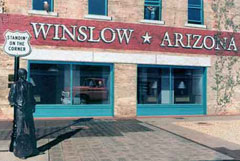Contact Pacific Southwest Brownfields
Pacific Southwest, Region 9
Serving: Arizona, California, Hawaii, Nevada, Pacific Islands, Tribal Nations
The Arizona Route 66 Partnership
History and Timeline
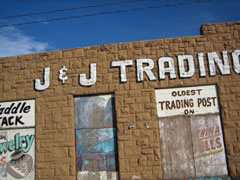
Established in 1926, Route 66 operated as the country's main east-west artery connecting Chicago and Los Angeles and everything in between with over 2,000 miles of continuously paved roadway. The cities and towns located along Route 66 reaped the benefits of the highway. Motels and diners sprang up to cater to travelers. Gas stations became the new icon for America's increasingly mobile society.
With the development of the nationwide interstate system, divided highways bypassed nearly all segments of Route 66 and in 1986, it was officially decommissioned. Though parts of the Route are no longer drivable, 85 percent of the highway is still in use by local and tourist traffic. As traffic moved to neighboring interstates, communities along Route 66 experienced economic and environmental hardships. With fewer travelers, many businesses closed, leaving behind neglected, abandoned properties.
Key Dates along the Route
Arizona’s Underground Storage Tank Removal and Cleanup Progress
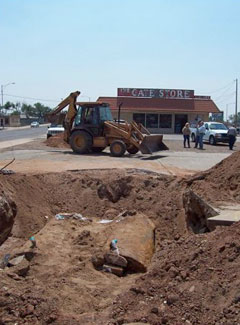
More than 200 miles of the original Route 66 runs through the northern part of Arizona. Along this stretch of highway, approximately 350 properties have reported contamination from USTs. In 2004, almost 100 properties along the Route 66 corridor had UST-related contamination remaining onsite. By 2010, this number had been reduced by more than 40 percent.
After reviewing all of the potential candidates for the Initiative, the Arizona Department of Environmental Quality (ADEQ) Underground Storage Tank Program focused special attention on Holbrook and Winslow where a high clay content makes cleanup difficult. ADEQ partnered with property owners, consultants and community representatives to expedite cleanup. Additionally, ADEQ assigned project case managers to each municipality or town, and designated a community liaison based in St. Johns, Arizona.
By 2010, work has been completed on more than 60 percent of the properties with leaking USTs in the Winslow and Holbrook area.
Also during this period, ADEQ managed UST removals and cleanups at more than 40 additional sites along Arizona’s stretch of Route 66, including the removal of numerous “orphan” tanks under the County and Municipal Tank Closure Program(CMTCP).
"ADEQ has done an excellent job of cleaning up contaminated properties along Route 66. The EPA is proud to join ADEQ to take the project even further. We want to explore ways to help support restoration and job creation along this historic route."
- Jeff Scott, Director Waste Management Division EPA Pacific Southwest Regional Office
Case Study: Standin’ on the Corner Park – Winslow, Arizona
As part of Winslow’s Renaissance Downtown Redevelopment, the Standin’ on the Corner Park was created to attract tourists who come to take their photo “standin’ on a corner in Winslow Arizona” as the Eagles sang in their hit song “Take it Easy.”
The park includes an impressive mural painted on the wall of the adjacent building, which is a former J.C. Penney department store. The park is a key tourist attraction for travelers following the Route, but it was closed when a fire severely damaged and destabilized the wall of the adjacent building. With the mural threatening to topple over on visitors, the city was forced to fence-off the park. The restricted access to the park caused a significant loss in revenue for businesses in downtown Winslow. Using EPA funding, ADEQ assisted the city with the evaluation and cleanup of environmental contamination that resulted from the fire. This project provides a good example of city, state and federal partners working together to restore economic prosperity and revitalize a downtown area.
Success Stories
Powerhouse Visitors Center – Kingman, Arizona
The Powerhouse Visitors Center in Kingman serves as a symbol of successful redevelopment and reuse along Route 66 in Arizona. Opened in 1907 to supply a centralized source of electric power to hoists and pumps in area mines, the construction of Hoover Dam in 1938 brought an end to the usefulness of the Powerhouse. In the 1990s, a partnership was formed to rehabilitate the building and the Powerhouse project received several grants from the State Heritage Fund Grant program for rehabilitation of the building.
Through the efforts of one local visionary, Toby Orr, the Powerhouse is now refurbished and serves as home to the Kingman Visitors Center and Tourist Information Desk, Kingman Chamber of Commerce, and the Historic Route 66 Association offices; it also welcomes more than 100,000 tourists a year. ThePowerhouse is an anchor for other historic redevelopment in the area.
In April 2008, EPA, ADEQ and the City of Kingman hosted a workshop to explore funding opportunities
with local government officials, property owners and consultants at the Powerhouse.
- Workshop flyer (PDF) (1 pg, 216K)
- Agenda (PDF) (1 pg, 267K)
Peach Springs – Hualapai Tribe

Peach Springs, the capital of the Hualapai people, lies along Route 66 at the road’s closest point to the Grand Canyon. From the start, Peach Springs was home to a variety of commercial activity including gas stations, lodging, restaurants, rafting, hunting, local art, craft, food, and railroad activity. When the new interstate highway bypassed and isolated Peach Springs, commercial activity declined and Peach Springs became a ghost town overnight. The Hualapai Tribe began to revitalize the town in 1990 building a modern lodge and restaurant.
Meanwhile, through the EPA Jobs Through Recycling Initiative, the Hualapai constructed an Earthship office building across the street from the lodge. The solar-powered Earthship building, constructed from local recycled materials, is a point of interest on Route 66. The new building has spurred installation of sidewalks throughout town helping to restore this once vibrant area. Also, the Tribe’s Cultural Center, reflecting the spiritual values of its culture, is the new focal point for Route 66 in Peach Springs.
Flagstaff, Arizona
City Takes the Lead with Federal and State Support
Flagstaff, Arizona has made significant strides in redeveloping the Route 66 corridor that runs through its downtown. The city purchased a 3.4- acre brownfield site along West Phoenix Avenue, home to a variety of commercial and industrial past uses. It received EPA Brownfields grants and ADEQ funding to conduct environmental assessment and cleanup of the property. In 2009, Flagstaff received American Recovery and Reinvestment Act (ARRA) funding to clean up a creosote pit on the site, along the original alignment of Route 66 at Phoenix Avenue. Soil was removed in 2010 and this cleanup will allow for a flood control project and make way for additional redevelopment.
On an area of the site that required no cleanup, the city constructed a transfer station, which provides a commuter parking lot, bike storage area and bus station in an easily accessible area of the city. Although the transfer station was planned only as the interim use for the property, its popularity among residents has encouraged the city to incorporate a transfer station into the redevelopment plan for the site.
Environmental Assessments Pave the Way for Reuse
The warehouse for Native Plant & Seed on East Brannen Avenue is a former railroad and was at one time a fuel distribution facility with above ground storage tanks. When the current owner purchased the property in 2003, he was told that railroad ties could be buried on the property, as an active but rarely used rail spur runs along the backside of the property.
The owner volunteered his property for a Phase I and II Environmental Site Assessment to determine the extent of contamination. The Phase II soil sampling and testing indicated there was no contamination of concern and no reason for further testing or cleanup. Now the owner no longer worries what may be lurking underground and can use the property in the way he sees fit.
Flagstaff Brownfield Land Recycling Program
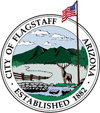
The City of Flagstaff Brownfield Land Recycling Program works with property owners within the Flagstaff city limits to revitalize contaminated land. Flagstaff grew up around the railroad, lumber mills and Route 66 fuel and repair shops, which left the city with a legacy of concerns of potential contamination. In order to reclaim this land and put it back into productive use, contamination issues must first be addressed. The Brownfield Land Recycling Program has been awarded almost $416,000 in Brownfields funding from EPA and ADEQ to conduct environmental site assessments and cleanups. Flagstaff’s success lies in its approach to redevelopment; instead of targeting one individual property at a time, the city has taken a corridor approach to revitalize a large portion of the Route 66 corridor to ensure an area-wide revitalization where property reuses are integrated with one another.
Historic Route 66 Association: Locals Take the Lead
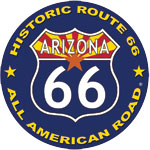
By the time the final stretch of Route 66 was bypassed in Williams, Arizona, in 1984, Arizona’s Route 66 main street businesses were struggling without the once steady stream of travelers. In 1987, local individuals formed the Historic Route 66 Association of Arizona and began to reclaim Route 66. The association helped Route 66 to earn the designation of an Arizona Historic Road, and then fought to get the brown historic highway signs to mark the entrances to the Route 66 main street businesses. The Bureau of Land Management designated a portion of Route 66 as a Scenic Back Country Byway, and in 2006, Arizona’s stretch of Route 66 was named a National Scenic Byway under the Federal Highway Administration’s America’s Byways Program.
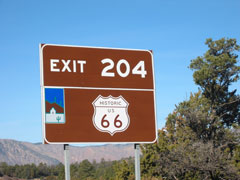
The association then took on the task of establishing a Historic Route 66 Byway Program to continue its mission to preserve, protect and promote Route 66. Under the program, grant awards assisted with establishing the program, developing marketing tools, and funding assessments of historic properties along the Route. The association continues to raise funds for preservation projects along the Route. In continuing its efforts to raise funds for Route 66 projects, in 2009 the association successfully secured an All-American Road designation for Route 66. All-American Road is the most prestigious designation possible under the Federal Highway Administration’s National Scenic Byways Program.
Resources
| Department, Agency, or Organization |
Available Resources | Funding Information | Brief Description | Website & Contact Info |
|---|---|---|---|---|
Federal Resources |
||||
U.S. Environmental Protection Agency (EPA) |
Brownfields Assessment, Cleanup, and Revolving Loan Fund (RLF) Grants | Up to $200,000 for Assessment and Cleanup grants. Up to $1 million for an Assessment Coalition or RLF. | EPA provides funding to inventory brownfields, assess sites for contamination, and clean sites if contamination is found. |
Laurie Martinez Amaro (amaro.laurie@epa.gov) Brownfields Coordinator & UST Project Officer |
| Brownfields Job Training Grants | Up to $200,000 available | EPA awards funding to train residents living near brownfields sites for future employment in the environmental field. | ||
| Targeted Brownfields Assessments | EPA and contracted consultants conduct assessments at no cost to eligible entities | Nonprofit and public entities such as cities, tribes, redevelopment agencies, or community development corporations are eligible to apply for assistance to conduct assessments. | ||
| Environmental Justice (EJ) Small Grants | Approximately $45,000 | Small Grants support communities to build collaborative partnerships to develop solutions to local environmental and public health issues. | Environmental Justice | |
| Community Action for a Renewed Environment (CARE) | Approximately $90,000 for “Level I” grants and $275,000 for “Level II” grants | The CARE Program encourages communities to form broad local partnerships to address toxic pollution in their environment. | CARE website | |
| Source Reduction Assistance Grants | $130,00 available per EPA Region | Funding provides assistance to environmental projects that reduce or eliminate pollution at the source. | Pollution Prevention Grants & Funding | |
U.S. Small Business Administration |
Various Loan Guarantee Programs | SBA has programs for as little as $300 to as much as $1.5 million | SBA has programs for as little as $300 to as much as $1.5 million. These loans are made through a bank, and SBA can guarantee as much as 85% of the loan. This depends on the type of the loan and the purpose of the loan. | National Programs Arizona Programs |
National Park Service |
Route 66 Corridor Preservation Program | Cost-share grants between $5,000 and $30,000 | Dedicated to collaboration with partners to provide funding, technical assistance, and education toward the long-term preservation of the most representative and significant resources of the historic Route 66 Corridor. | National Park Service Kaisa Barthuli (kaisa_barthuli@nps.gov) Rt. 66 Corridor Preservation Program (505) 988-6701 |
USDA Rural Development |
Rural Business Enterprise Grant Program (RBEG) | Generally, grants range from $10,000 up to $500,000. Smaller projects are given priority. | The RBEG program provides grants for rural projects that finance and facilitate development of small and emerging rural businesses, help fund distance learning networks, and help fund employment related adult education programs. | USDA Rural Development, Arizona Alan Watt Loan Specialist (alan.watt@az.usda.gov) |
| Rural Business Opportunity Grants (RBOG) | Maximum of $50,000 | Promotes sustainable economic development in rural communities with exceptional needs. Differs from REGB Grants in that the funds may be used for any size business (not just small businesses). | ||
U.S. Department of Transportation – Federal Highway Administration |
National Scenic Byways Program | $3 million | Grants and technical assistance provided to implement planning and development projects on highways designated as National Scenic Byways (e.g., Route 66). Recognizes roads having outstanding scenic, historic, cultural, natural, recreational, and archaeological qualities. | National Scenic Byways Program grants |
Arizona Department of Environmental Quality |
Brownfields Assistance Program | Site specific grants of approximately $50,000 available under the State Response Grant section | Provides funding and technical assistance to assess and clean up property where reuse is complicated by the presence or potential presence of hazardous substances or pollutants. ADEQ receives federal funding for this program for its State Response Grants (SRG), which are used to fund assessment grants. | ADEQ Brownfields Assistance Program Juli Boles Brownfields (jb6@azdeq.gov) |
| County and Municipal Tank Closure Program (CMTCP) | If funds are available, ADEQ completes UST closure at no cost to the property owner or community | The program completes UST closure at no cost to the property owner or the community. The site must be located in unincorporated areas of counties or incorporated communities of fewer than 15,000 people; the UST must be abandoned or orphaned; and the county, city, or town must apply, and application costs may be reimbursed. | ADEQ UST program |
|
| State Lead Program | If funds are available, ADEQ will pay 100% of the cleanup costs for sites where the property owner did not own or operate the USTs at the time of the release | ADEQ conducts UST corrective actions that the agency determines are necessary to protect human health and the environment at sites where the owner is unknown, unwilling, or technically or financially unable to perform the necessary work. | ||
| Route 66 Asbestos Initiative | Technical Assistance | Provides asbestos compliance assistance to rural communities in Arizona through awareness seminars. Offers outreach and education to ensure safe handling and disposal of asbestos. | ADEQ Air Quality Division Theresa Rigney (TR3@azdeq.gov) Air Quality Inspections and Field Services Unit (602) 771-2286 |
|
| Voluntary Remediation Program (VRP) | All applicants must submit a non-refundable $2,000 application fee with application. Once a site is accepted into the program, a positive balance must be maintained. An invoice for $4,000 is issued when the site is accepted and every time the balance falls below $1,000 | Allows interested parties to volunteer and work cooperatively with the ADEQ to clean up contaminated properties and return the site to beneficial use. | ADEQ Voluntary Remediation Program
|
|
Arizona Department of Housing (ADOH) |
Community Development Block Grant (CDBG) | ADOH receives approximately $13 million in federal CDBG funding each year to distribute to rural towns, cities, and counties in Arizona | CDBG funds are used for a variety of projects including public works and infrastructure, community facilities, public services, housing rehabilitation, and economic development. Rural towns, cities, and counties who receive CDBG funding are also eligible to receive additional CDBG funding on a competitive basis. | Arizona Department of Housing (602) 771-1000 |
Arizona Department of Transportation |
Transportation Enhancement | Total annual funds of up to $16 million. This is a reimbursement program and requires and 5.7% cash match. | The Transportation Enhancement (TE) program was developed to enhance surface transportation by developing projects that go above and beyond what transportation departments typically do. The ADOT Transportation Enhancement and Scenic Roads Section administers this federally-funded program. | Transportation Enhancement |
| Scenic Roads and Byways | Total annual funds of $30 million. This is a reimbursement program and requires a 20% match in cash, materials, and/or in-kind services. | Provides federal funding to protect, preserve, and enhance national and state-designated Scenic Byways. The ADOT Transportation Enhancement and Scenic Roads Section administers this federally-funded program. | Scenic Roads and Byways |
|
Arizona Commerce Authority |
Rural Economic Development Initiatives (REDI) | Provides both technical and matching fund assistance | Program provides direct assistance to rural communities in organizing an economic development program or effort, and evaluating community resources. Qualified rural economic development programs and organizations can be recognized through REDI accreditation. | Rural Economic Development Initiatives |
| Main Street Program | Funds available for minor exterior improvements (e.g., paint) | Fosters economic development within the context of historic preservation by working as a partner with local and state agencies, property owners, and business people to revitalize downtown areas. | Main Street Program |
|
Arizona Department of Tourism |
Arizona Rural and Regional Marketing Grant Program | If funds are available, $16,000 for Individual Grants or $80,000 for Regional Grants with a 50% match required. For Fiscal Year 2011, all grant programs have been suspended. | Matching grant program to assist regional partnerships, tribal tourism organizations, statewide tourism organizations, and Destination Marketing Organizations with tourism advertising and marketing efforts. | Arizona Rural and Regional Marketing Grant Program Glenn Schlottman (gschlottman@azot.gov) (602)364-3727 |

